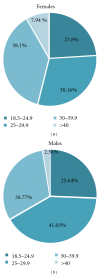Links between metabolic syndrome and cardiovascular autonomic dysfunction
- PMID: 22474426
- PMCID: PMC3312199
- DOI: 10.1155/2012/615835
Links between metabolic syndrome and cardiovascular autonomic dysfunction
Abstract
Background: Type 2 diabetes (T2D) might occur within metabolic syndrome (MbS). One of the complications of T2D is an impaired (imp) cardiovascular autonomic function (CAF).
Aims: In subjects with T2D and age ≤ 55 years, the prevalence of impCAF and its relationship with BMI, waist, HbA(1c) values, MbS, hypertension, and family history of T2D and/or hypertension were analysed.
Methods: 180 subjects consecutively undergoing a day hospital for T2D were studied. The IDF criteria were used to diagnose MbS. To detect impCAF, 5 tests for the evaluation of CAF were performed with Cardionomic (Meteda, Italy). Univariate and multivariate analyses were performed.
Results: The prevalence of impCAF and MbS were 33.9% and 67.8%, respectively. Among diabetics with impCAF, 86.9% had MbS. ImpCAF was significantly associated with MbS, overweight, and HbA(1c) > 7%. Both logistic (P = 0.0009) and Poisson (P = 0.0113) models showed a positive association between impCAF and MbS. The degree of ImpCAF showed a positive linear correlation with BMI and HbA(1c) values.
Conclusions: The study demonstrates that glycaemic control and overweight influence CAF and that T2D + MbS is more strongly associated with impCAF than isolated T2D. We suggest that MbS not only increases the cardiovascular risk of relatively young subjects with T2D but is also associated with impCAF.
Figures





Similar articles
-
Type 2 Diabetes Mellitus Is Independently Associated With Decreased Neural Baroreflex Sensitivity: The Paris Prospective Study III.Arterioscler Thromb Vasc Biol. 2020 May;40(5):1420-1428. doi: 10.1161/ATVBAHA.120.314102. Epub 2020 Mar 19. Arterioscler Thromb Vasc Biol. 2020. PMID: 32188272
-
Diabetes Mellitus in German Primary Care: quality of glycaemic control and subpopulations not well controlled - results of the DETECT study.Exp Clin Endocrinol Diabetes. 2009 Jan;117(1):6-14. doi: 10.1055/s-2008-1073127. Epub 2008 May 9. Exp Clin Endocrinol Diabetes. 2009. PMID: 18465681
-
The association between the spatial QRS-T angle with cardiac autonomic neuropathy in subjects with Type 2 diabetes mellitus.Diabet Med. 2010 Dec;27(12):1420-9. doi: 10.1111/j.1464-5491.2010.03120.x. Diabet Med. 2010. PMID: 21059095
-
Diabetic autonomic neuropathy.Diabetes Care. 2003 May;26(5):1553-79. doi: 10.2337/diacare.26.5.1553. Diabetes Care. 2003. PMID: 12716821 Review.
-
Diabetic cardiovascular autonomic neuropathy: risk factors, clinical impact and early diagnosis.Arq Bras Cardiol. 2008 Apr;90(4):e24-31. doi: 10.1590/s0066-782x2008000400014. Arq Bras Cardiol. 2008. PMID: 18516377 Review. English, Portuguese.
Cited by
-
Comparison of prediction model for cardiovascular autonomic dysfunction using artificial neural network and logistic regression analysis.PLoS One. 2013 Aug 5;8(8):e70571. doi: 10.1371/journal.pone.0070571. Print 2013. PLoS One. 2013. PMID: 23940593 Free PMC article.
-
Cardiovascular changes in animal models of metabolic syndrome.J Diabetes Res. 2013;2013:761314. doi: 10.1155/2013/761314. Epub 2013 Mar 14. J Diabetes Res. 2013. PMID: 23691518 Free PMC article.
-
Clinical risk model assessment for cardiovascular autonomic dysfunction in the general Chinese population.J Endocrinol Invest. 2015 Jun;38(6):615-22. doi: 10.1007/s40618-014-0229-8. Epub 2015 Jan 3. J Endocrinol Invest. 2015. PMID: 25555369
-
The analysis of a reference value for baroreflex sensitivity and cardiovascular autonomic neuropathy prevalence in a Chinese population.Eur J Med Res. 2014 Feb 12;19(1):8. doi: 10.1186/2047-783X-19-8. Eur J Med Res. 2014. PMID: 24521230 Free PMC article.
-
Bayesian estimation of cardiovascular autonomic neuropathy diagnostic test based on short-term heart rate variability without a gold standard.BMJ Open. 2014 Oct 6;4(9):e005096. doi: 10.1136/bmjopen-2014-005096. BMJ Open. 2014. PMID: 25287103 Free PMC article.
References
-
- Vinik AI, Erbas T. Recognizing and treating diabetic autonomic neuropathy. Cleveland Clinic Journal of Medicine. 2001;68(11):928–944. - PubMed
-
- Langer A, Freeman MR, Josse RG, Steiner G, Armstrong PW. Detection of silent myocardial ischemia in diabetes mellitus. American Journal of Cardiology. 1991;67(13):1073–1078. - PubMed
-
- Low PA, Benrud-Larson LM, Sletten DM, et al. Autonomic symptoms and diabetic neuropathy: a population-based study. Diabetes Care. 2004;27(12):2942–2947. - PubMed
-
- Grundy SM, Cleeman JI, Daniels SR, et al. Diagnosis and management of the metabolic syndrome: an American heart association/national heart, lung, and blood institute scientific statement. Circulation. 2005;112(17):2735–2752. - PubMed
MeSH terms
Substances
LinkOut - more resources
Full Text Sources
Medical
Miscellaneous
